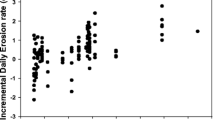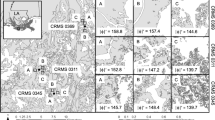Abstract
Aquatic biodiversity continues to decline as humans modify the landscape, mainly because of stream habitat alterations and loss caused by urban development. Bluehead chubs may mitigate some effects of instream habitat degradation by providing clean gravel substrate via their spawning nests. We used path analysis, an extension of multiple linear regression, to explore the relationships among instream habitat degradation, adult chub abundance, chub nesting activity, and chub reproductive performance. Age-0 chub abundance was best explained by small adult abundance and nest abundance. Habitat disturbance indirectly and negatively influenced age-0 chub abundance through adult chubs and nest abundance. Percentages of pool and run habitat also had indirect negative effects on age-0 chub abundance. Several metrics of chub nesting activity (nest density [proportion of substrate occupied by nests], average nest size, and number of nests) were explained by both adult chub abundance and nesting site conditions. Variability among stream systems described significant variation in adult chub abundance and nesting characteristics and, if unaccounted for, would have resulted in large unexplained variability. Chub nesting activity served as a link between habitat degradation, adult chub abundance, and their reproductive performance. Our study provides preliminary evidence that bluehead chubs’ nesting activity may be a mechanism of their persistence in degraded stream reaches. We recommend confirmatory studies through in-stream manipulative experiments.


Similar content being viewed by others
References
Albanese B, Angermeier PL, Dorai-Raj S (2004) Ecological correlates of fish movement in a network of Virginia streams. Can J Fish Aquatic Sci 61:857–869
Arnold CL, Boison PJ, Patton PC (1982) Sawmill Brook: an example of rapid geomorphic change related to urbanization. J Geol 90:155–166
Balon EK (1975) Reproductive guilds of fishes—proposal and definition. J Fish Res Board Can 32:821–864
Barbour MT, Gerristen J, Snyder BD, Stribling JB (1999) Rapid bioassessment protocols for use in streams and wadeable rivers: periphyton, benthic macroinvertebrates and fish, 2nd edition. U. S. Environmental Protection Agency, Office of Water EPA 841-B-99-002. Washington, DC
Becker GC (1983) Fishes of Wisconsin. University of Wisconsin Press, Madison, WI
Berkman HE, Rabeni CF (1987) Effect of siltation on stream fish communities. Environ Biol Fish 18:285–294
Bisazza A, Marconato A, Marin G (1989) Male competition and female choice in Padogobius martensi (Pisces, Gobiidae). Anim Behav 38:406–413
Carlisle DM, Hawkins CP, Meador MR, Potapova M, Falcone J (2008) Biological assessments of Appalachian streams based on predictive models for fish, macroinvertebrate, and diatom assemblages. J N Am Benthol Soc 27:16–37
DeVries DR, Frie RV (1996) Determination of age and growth. In: Murphy BR, Willis DW (eds) Fisheries techniques, 2nd edn. American Fisheries Society, Bethesda, MD, pp 483–512
Fausch KD, Torgersen CE, Baxter CV, Li HW (2002) Landscapes to riverscapes: bridging the gap between research and conservation of stream fishes. BioScience 52:1–16
Fitzpatrick FA, Waite IR, D’Arconte PJ, Meador MR, Maupin MA, Gurtz ME (1998) Revised methods for characterizing stream habitat in the National Water-Quality Assessment Program. United States Geologic Survey Water Resources Investigation Report 98-4052 Raleigh, NC
Frissell CA, Liss WJ, Warren CE, Hurley MD (1986) A hierarchical framework for stream habitat classification: viewing streams in a watershed context. Environ Manag 10:199–214
Garrick T, Gilliam JF (2000) Modeling diffusive spread in a heterogeneous population: a movement study with stream fish. Ecology 81:1685–1700
Goldstein RM, Simon TP (1999) Toward a united definition of guild structure for feeding ecology of North American freshwater fishes. In: Simon TP (ed) Assessing the sustainability and biological integrity of water resources using fish communities. CRC, Boca Raton, FL, pp 124–139
Gray MA, Curry AR, Munkittrick KR (2002) Non-lethal sampling methods for assessing environmental impacts using a small-bodied sentinel fish species. Water Quality Res J of Can 37:195–211
Hubert WA, Fabrizio MC (2007) Relative abundance and catch per unit effort. In: Guy CS, Brown ML (eds) Analysis and interpretation of freshwater fisheries data. American Fisheries Society, Bethesda, MD, pp 279–325
Hughes RM, Kaufmann PR, Herlihy AT, Kincaid TM, Reynolds L, Larsen DP (1998) A process for developing and evaluating indices of fish assemblage integrity. Can J Fish Aquat Sci 55:1618–1631
Jenkins RE, Burkhead NM (1993) Freshwater fishes of Virginia. American Fisheries Society, Bethesda, MD
Johnston CE (1994) The benefit to some minnows of spawning in the nests of other species. Environ Biol Fish 40:213–218
Johnston CE (1999) The relationship of spawning mode to conservation of North American minnows (Cyprinidae). Environ Biol Fish 55:21–30
Johnston CE, Page LM (1992) The evolution of complex reproductive strategies in North American minnows (Cyprinidae). In: Mayden RL (ed) Systematics, historical ecology, and North American Freshwater Fishes Standford University Press, Stanford, CA, pp 600–621
Jolliffe IT (2002) Principal components analysis, 2nd edn. Springer, New York, NY
Joy MK, Death RG (2002) Predictive modelling of freshwater fish as a biomonitoring tool in New Zealand. Freshw Biol 47:2261–2275
Karr JR (1981) Assessment of biotic integrity using fish communities. Fisheries 6:21–27
Karr JR, Fausch KD, Angermeier PL, Yant PR, Schlosser IJ (1986) Assessment of biological integrity in running water: a method and its rationale. Illinois Natural History Survey Special Publication, Number 5 Champaign, IL
Lachner EA (1952) Studies of the biology of the cyprinid fishes of the chub genus Nocomis of northeastern United States. Am Midl Nat 48:433–457
Leopold LB, Huppman R, Miller A (2005) Geomorphic effects of urbanization in forty-one years of observation. Proc Am Philos Soc 149:349–371
Li C (1975) Path analysis: a primer. Boxwood, Pacific Grove, CA
Lindstrom K (1992) The effect of resource holding potential, nest size and information about resource quality on the outcome of intruder-owner conflicts in the sand goby. Behav Ecol Sociobiol 30:53–58
Lisle TE (1987) Using “residual depths” to monitor pool depths independently of discharge. United States Department of Agriculture Res Note PSW-394 Berkley, CA
Lobb MD III, Orth DJ (1988) Microhabitat use by the bigmouth chub Nocomis platyrynchus in the New River, West Virginia. Am Midl Nat 120:32–40
Mallows CL (1973) Some comments on Cp. Technometrics 15:661–675
Marcy BC Jr, Fletcher DE, Martin FD, Paller MH, Reichert MJM (2005) Fishes of the Middle Savannah River Basin: with emphasis on the Savannah River Site. University of Georgia Press, Athens, GA
Maurikis EG, Woolcoot WS, Sabaj MH (1991) Reproductive-behavioral phylogenetics of Nocomis species-groups. Am Midl Nat 126:32–40
Meador MR, Coles JF, Zappia H (2005) Fish assemblage responses to urban intensity gradients in contrasting metropolitan areas: Birmingham, Alabama and Boston, Massachusetts. In: Brown LR, Gray RH, Hughes RM, Meador MR (eds) American fisheries society symposium 47. American Fisheries Society, Bethesda, MD, pp 409–423
Merigoux S, Doledec S, Statzner B (2001) Species traits in relation to habitat variability and state: neotropical juvenile fish in floodplain creeks. Freshw Biol 46:1251–1267
Power ME (2007) Fish population bioassessment. In: Guy CS, Brown ML (eds) Analysis and interpretation of freshwater fisheries data. American Fisheries Society, Bethesda, MD, pp 561–622
Reid SM, Jones NE, Yunker G (2008) Evaluation of single-pass electrofishing and rapid habitat assessment for monitoring redside dace. N Am J Fish Manag 28:50–56
Richards C, Bacon KL (1994) Influence of fine sediment on macroinvertebrate colonization of surface and hyphoreic stream substrates. Gt Basin Nat 54:106–113
Sabaj MH, Maurikis EG, Woolcott WS (2000) Spawning behaviors in the bluehead chub, Nocomis leptocephalus, river chub, Nocomis micropogon and central stoneroller, Campostoma anomalum. Am Midl Nat 144:187–201
Schlosser IJ (1995) Critical landscape attributes that influence fish population dynamics in headwater streams. Hydrobiologia 303:71–81
Schlosser IJ, Angermeier PL (1995) Spatial variation in demographic processes of lotic fishes: conceptual models, empirical evidence, and implications for conservation. In: Evolution and the aquatic ecosystem: Defining unique units in population conservation. American Fisheries Society Symposium American Fisheries Society, Bethesda, MD, pp 392–401
Shipley B (2002) Cause and correlation in biology: a user’s guide to path analysis, structural equations, and causal inference. Cambridge University Press, New York, NY
Shipley B, Vile D, Garnier E (2006) From plant traits to plant communities: a statistical mechanistic approach to biodiversity. Science 314:812–814
Sponseller RA, Benfield EF, Valett HM (2001) Relationships between land use, spatial scale and stream macroinvertebrate communities. Freshw Biol 46:1409–1424
Starnes LB, Starnes WC (1981) Biology of the blackside dace Phoxinus cumberlandensis. Am Midl Nat 106
Suter GW II (1993) Ecological risk assessment, 2nd edn. CRC, Boca Raton, FL
Taylor BR, Roff JC (1986) Long-term effects of highway construction on the ecology of a southern Ontario stream. Environ Pollut A 40:317–344
Vives SP (1990) Nesting ecology and behavior of hornyhead chub Nocomis biguttatus, a keystone species in Allequash Creek, Wisconsin. Am Midl Nat 124:46–56
Waits ER, Bagley MJ, Blum MJ, McCormick FH, Lazorchak JM (2008) Source-sink dynamics sustain central stonerollers (Campostoma anomalum) in a heavily urbanized catchment. Freshw Biol 53:2061–2075
Wallin JE (1989) Bluehead chub (Nocomis leptocephalus) nests used by yellowfin shiners (Notropis lutipinnis). Copeia 1989:1077–1080
Weaver LA, Garman GC (1994) Urbanization of a watershed and historical changes in a stream fish assemblage. Trans Am Fish Soc 123:162–172
Werner EE, Gilliam JF (1984) The ontogenetic niche and species interactions in size-structured populations. Annu Rev Ecol Systematics 15:393–425
Wisenden BD, Unruh A, Morantes A, Bury S, Curry B, Driscoll R, Hussein M, Markegard S (2009) Functional constraints on nest charactaristics of pebble mounds of breeding male hornyhead chub Nocomis biguttatus. J Fish Biol 75:1577–1585
Acknowledgements
This research was funded by a grant from the Virginia Agricultural Experimental Station. We also thank J. Pritt, R. Pendleton, A. Geisler, V. Wooton, J. T. Deweber, Y. Ansah, M. L. Henebry, and J. Herrala for help with field work.
Author information
Authors and Affiliations
Corresponding author
Rights and permissions
About this article
Cite this article
Peoples, B.K., Tainer, M.B. & Frimpong, E.A. Bluehead chub nesting activity: a potential mechanism of population persistence in degraded stream habitats. Environ Biol Fish 90, 379–391 (2011). https://doi.org/10.1007/s10641-010-9748-0
Received:
Accepted:
Published:
Issue Date:
DOI: https://doi.org/10.1007/s10641-010-9748-0




